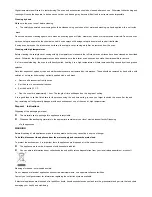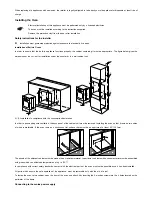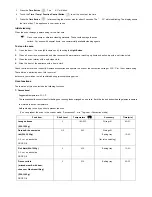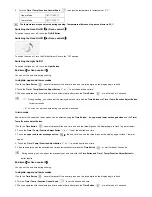
Higher temperatures will result in faster burning.The oven and accessories should be cleaned after each use. Otherwise further baking and
roasting will cause the deposits to bake on even harder and cleaning may become difficult and in extreme cases impossible.
Cleaning by hand
Make sure the oven is cool before cleaning.
●
The catalytic enameled cover casing should be cleaned using a solution of hot water and washing-up liquid applied with a soft nylon
brush.
Do not use abrasive cleaning agents, hard brushes, scouring pads or cloths, steel wool, knives or other abrasive materials.Do not use oven
spray on catalytic enamel as the chemicals used in oven sprays will damage catalytic enamel and render it ineffective.
If using oven sprays on the interior oven surfaces, the catalytic cover casing must first be removed from the oven.
Cleaning with high temperatures
Before cleaning the catalytic cover casing with high temperatures, make sure that all interior oven surfaces have been cleaned as described
above. Otherwise, the high temperatures can bake deposits onto the interior oven surfaces and make them impossible to remove.
If, after manual cleaning, the oven is still heavily soiled, heating it to a high temperature will help remove soiling caused by oil and grease
splashes.
Note that deposits of spices, syrups and similar substances are not removed by this process. These should be removed by hand with a mild
solution of hot water and washing-up liquid applied with a soft brush.
●
Remove all accessories from the oven.
●
Set the oven to conventional function.
●
Set the heat to 250 °C.
●
Run the oven for approximately 1 hour. The length of time will depend on the degree of soiling.
It is a good idea to set the finish time for the process using the end time setting, in case you forget to switch the oven off at the end.
Any remaining soil will gradually disappear with each subsequent use of the oven at high temperatures.
Disposal Instructions
Disposing of the packaging material
The material used to package this appliance is recyclable.
Dispose of the packaging materials in the appropriate container at your local waste disposal facility Disposing
of old appliances
WARNING
Before disposing of old appliances, make them inoperable so that they cannot be a source of danger.
To do this, disconnect the appliance from the mains supply and remove the mains lead.
To protect the environment, it is important that old appliances are disposed of in the correct manner.
The appliance must not be disposed of with household rubbish.
You can obtain information about collection dates and public refuse disposal sites from your local refuse department or council.
Meaning of crossed –out wheeled dustbin:
Do not dispose of electrical appliances as unsorted municipal waste, use separate collection facilities.
Contact you local government for information regarding the collection systems available.
If electrical appliances are disposed of in landfills or dumb, hazardous substances can leak into the groundwater and get into the food chain,
damaging your health and well-being.






































